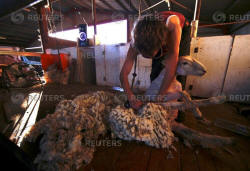Australian drought, sporty shoppers push up prices of
wool clothing
 Send a link to a friend
Send a link to a friend
 [November 21, 2018]
By Sonya Dowsett and Jonathan Barrett [November 21, 2018]
By Sonya Dowsett and Jonathan Barrett
MADRID/SYDNEY (Reuters) - A jump in the
price of wool from drought-ravaged Australia, the world's top exporter
of high-quality fleeces, is rattling through the global clothing supply
chain, with some mills passing along costs and retailers cutting down on
wool or raising prices.
Italian clothmaker Botto Giuseppe, which supplies luxury brands Giorgio
Armani SpA and Max Mara, says it has increased prices on average by 7 to
8 percent in the last year on wool fabric, while high-end Swiss-based
sportswear label Mover has put up the retail price of its merino wool
t-shirts by 15 percent.
"The wool price has increased consistently over the past three years,"
said Silvio Botto Poala, Chief Executive Officer of Botto Giuseppe, a
142-year-old company. "But the big jump has been in the past year."
Neither Armani or Max Mara immediately responded to requests for
comment.

Meanwhile, Swedish fast fashion company H&M <HMb.ST> has cut down on the
amount of wool it uses in production, it said in an emailed response to
Reuters' questions, thus avoiding price rises on items like wool-blend
sweaters and coats. It declined to give further details.
Botto Giuseppe has increased the price of wool flannel fabric used for
suits to 19.50 euros per meter compared to 18 euros a year ago, CEO
Botto Poala said. Pure merino wool t-shirts from Swiss skiwear label
Mover retail for 75 euros ($85), compared to 65 euros last year, CEO
Nicolas Rochat said.
Pendleton, a sixth-generation-owned, Oregon-based textile company known
for its plaid woolen shirts, said it would put up some of its prices
next year due to higher wool prices.
"We won't go into less expensive wools, we will just have to take a
sharper margin and we'll have to increase the price," said John Bishop,
CEO of the company which has collaborated with Nike <NKE.N> on a range
of plaid wool sneakers.
The privately-held company declined to give details on how margins will
be affected. Nike did not respond to several requests for comment.
Wool has become increasingly popular for use in sportswear due to its
temperature regulating properties and a surge in demand for sustainable
fabrics, particularly from younger consumers, manufacturers and farmers
say.
But the jump in demand has coincided with a sustained drought in the
east of Australia, which supplies over 90 percent of the world's
exported high-quality wool used in clothing.
BUYERS PUSH BACK
Lack of rain has turned pastures barren, driving farmers to bring in
expensive feed. Many have had to send livestock to abattoirs, prompting
Australia's chief commodity forecaster ABARES to cut wool production
forecasts by 4 percent this year.
[to top of second column] |


Anthony Uren, manager at the Congi farm in the north-east of New South Wales,
said he was keeping his 36,000 merino sheep fed on parched paddocks by bringing
in feed like hay and barley.
"We've never had less rainfall than we've had this year," said Uren, who
supplies wool to Botto Giuseppe, among others.
Benchmark prices for high-quality Australian wool were trading at more than A$21
($15.40) a kg in August, up from A$16 a year earlier.
The effects of drought are now clearly visible to wool growers and buyers.
Fleeces of animals affected by drought are thinner and often tainted by dust,
said buyer Andrew Blanch, managing director of Italian textile maker-owned New
England Wool. Clients of Chinese wool mills are also starting to balk at the
high prices, leading to a stand-off between buyers and sellers and some bales
being left unsold, said Michael Jones, chief executive of Australia's dominant
wool storage and export house, AWH.
As a result, prices have retreated 15 percent since September, according to
Australian Wool Innovation auction price reports. But prices are still near
historical highs and sellers know they are in possession of an in-demand product
facing supply shortages, Jones said.
ACTIVE WEAR
Demand for wool active wear in particular continues to grow.
Italian clothmaker Reda started to produce woolen sports fabrics after the
financial crash of 2008 which saw demand for suits tumble, said CEO Ercole Botto
Poala, who is related to the chief executive of Botto Giuseppe.
Wool active wear fabric now makes up 10 percent of the company's 110 million
euro annual turnover and is its fastest-growing product range, he said. The
company bought new factory space in May to keep up with consumer demand, he
said. Reda's clients range from San Francisco-based wool sneaker brand Allbirds,
popular with Silicon Valley tech workers, to luxury label Zegna which uses its
trade-marked fabric Techmerino in a range of pure wool casual wear including
sweatpants. Reda has put up its prices in response to higher wool prices, but
declined to say by how much. Neither Allbirds nor Zegna would comment on the
matter.

($1 = 1.3712 Australian dollars)
(Additional reporting by Anna Ringstrom in Stockholm. Editing by Lincoln Feast.)
[© 2018 Thomson Reuters. All rights
reserved.] Copyright 2018 Reuters. All rights reserved. This material may not be published,
broadcast, rewritten or redistributed.
Thompson Reuters is solely responsible for this content. |